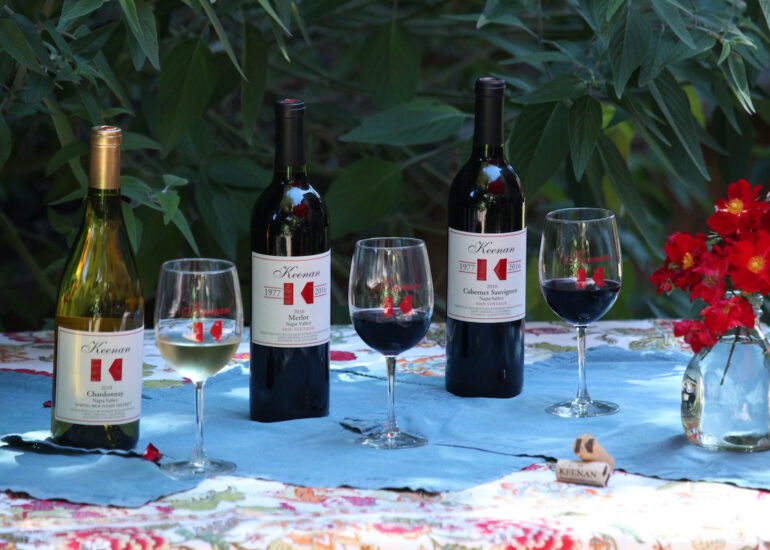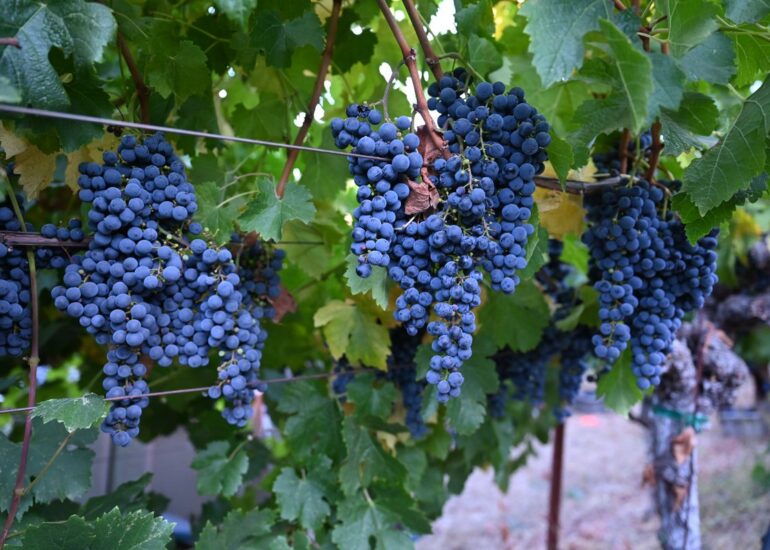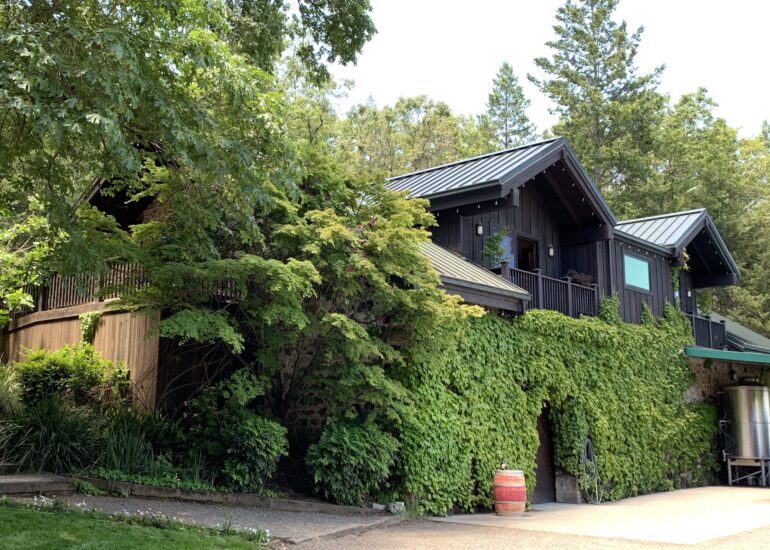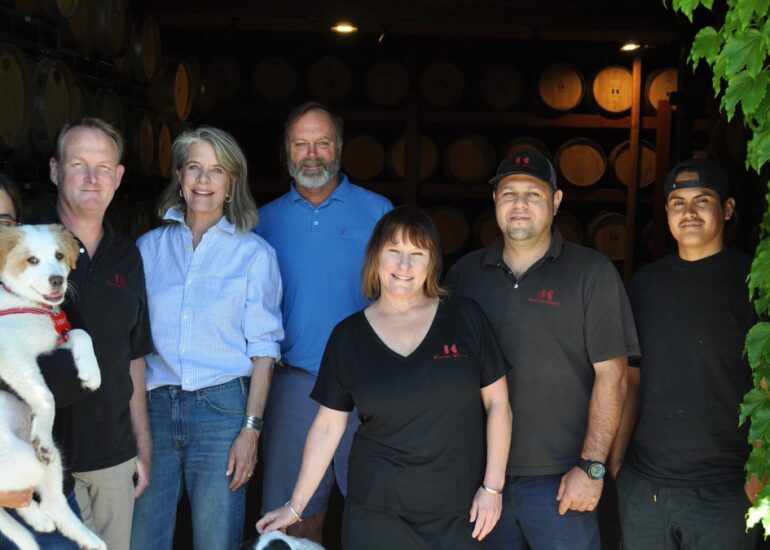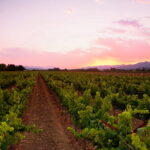Keen on Keenan
Winemaker Interview
Keen on Keenan
A conversation with Michael Keenan of Napa's Keenan Winery
Winery Heir Furthers Father’s Legacy on Napa’s Spring Mountain
An Interview with Proprietor of Keenan Winery
It was by virtue of his hillside Napa Merlot that Robert Keenan planted his eponymous winery squarely on the world’s wine map twenty years ago. Since then, a new generation of ownership under his son has resulted in significant changes in vineyard practices, varietal choices, and overall business philosophy that have propelled the producer well into the modern era of premium winemaking. Although bolstering its reputation in recent years through the crafting of fine wines from Cabernets Sauvignon and Franc, Keenan Winery continues to produce Merlot of superb quality, threatening to help bring the varietal back into vogue following its recent fall from market popularity. I spoke with proprietor Michael Keenan on the evolution of his winery’s production, the virtues of raising vines on Spring Mountain, and the lessons learned from the daunting task of furthering his father’s legacy.
A diplomatic, inclusive, and compassionate man, Michael Keenan runs the winery he inherited with a rather fresh emphasis on forging and maintaining relationships with employees and industry colleagues alike. Combined with his ‘keen’ attention to detail and overall business savvy, this has allowed the brand to flourish in recent years through such forward-thinking changes in the vineyard as planting new clones while mindful of site specificity and implementing practices in sustainability that have seen measurable results. And yet even in their enthusiasm for change, Keenan and his team have remained focused on producing wines that are truly reflective of the local terroir, standing firmly in the winds of the past decade’s swaying market trends. All the more inspiring was listening to him share the lessons he has learned from raising vines and making wines that have enabled him to grow not only as a businessman, but also as a husband and father.
— Nikitas Magel
Following are edited excerpts from the interview. At the bottom of this post is the full recording.

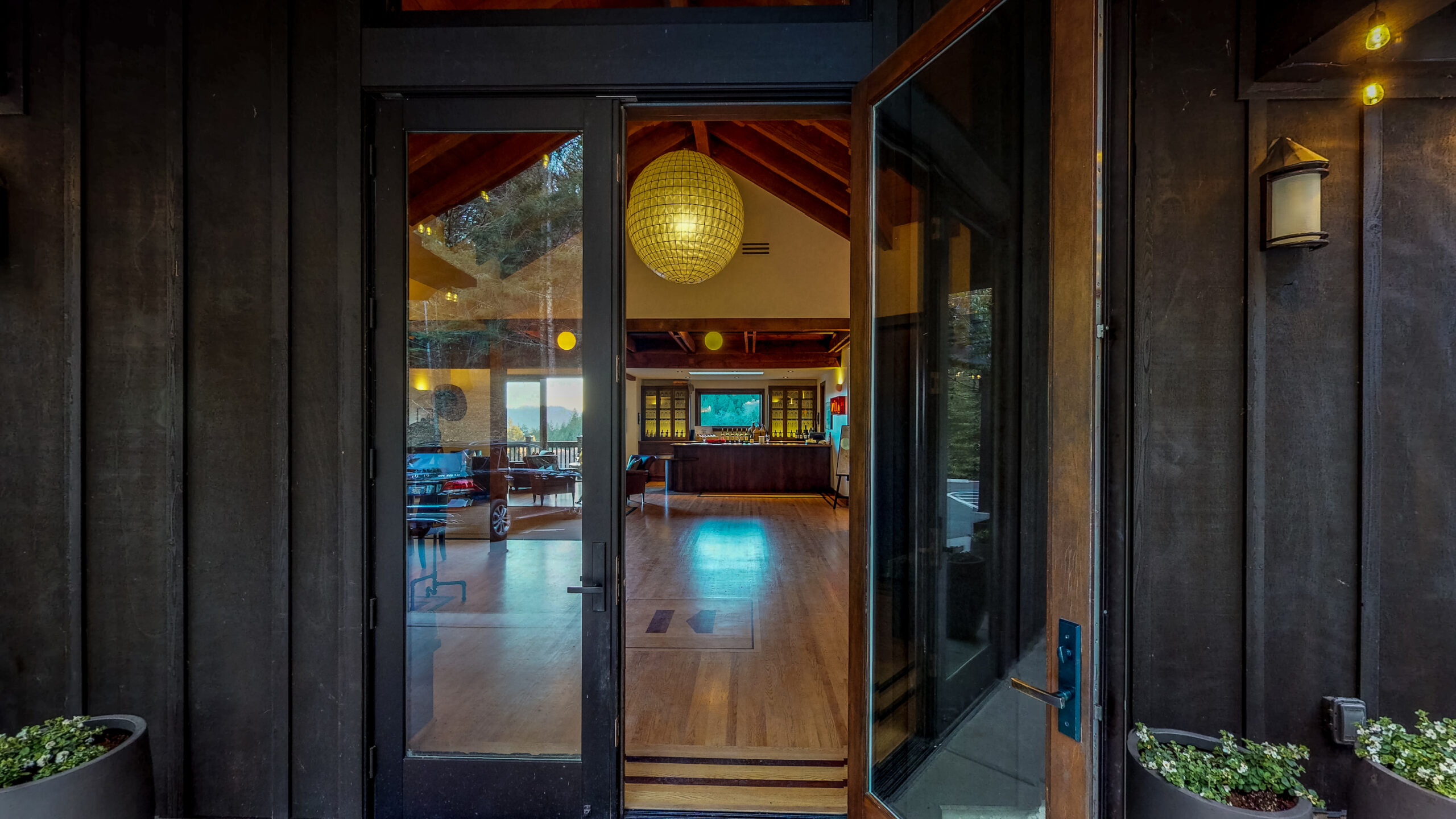
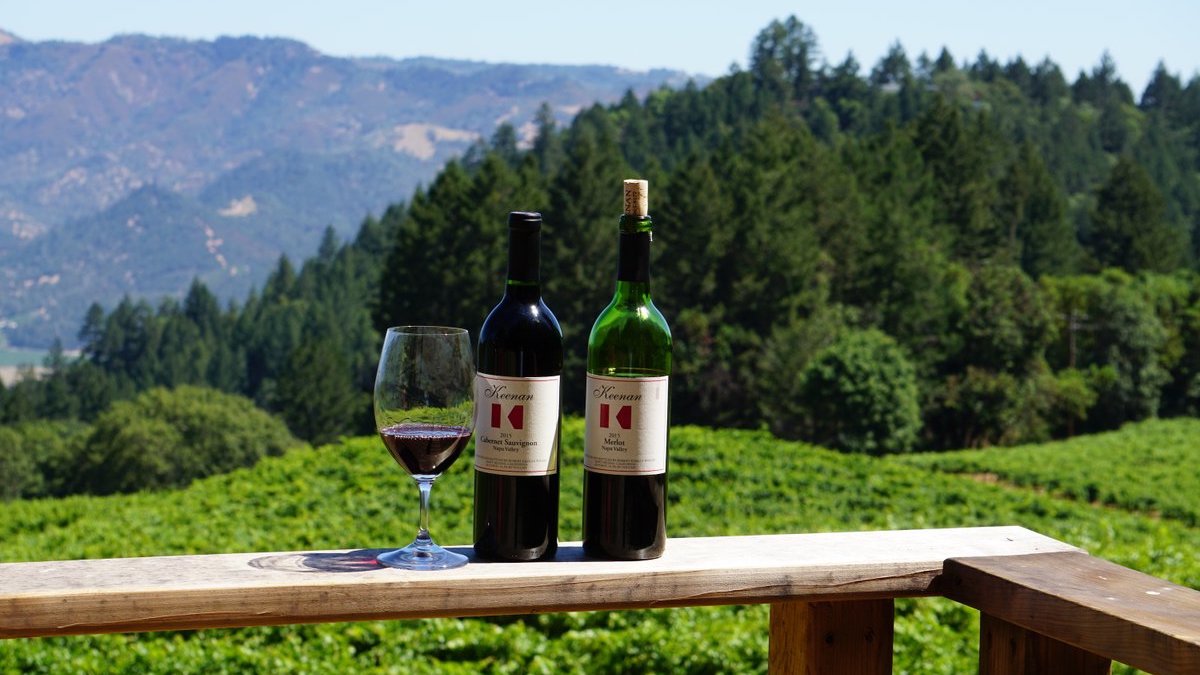
Challenging Assumptions, Garnering Attention
Nikitas Magel: I was first introduced to Keenan wine through your Napa Merlot, which, at the time, was widely considered among the best. Years later, I still get a sense that’s what you’re known for.
Michael Keenan: We’ve historically grown three varietals: Cabernet, Chardonnay, and Merlot. But I think Merlot was the first varietal we got really good at. And the reason is that this site is so well-suited for Merlot that it’s involved less of a discovery process than Cabernet and Chardonnay. With those other varietals, we had to learn things that were different than what we thought we were going to do, and had to work to change our philosophy and try new things before we really hit our stride. With the Chardonnay, specifically, a lot of the challenge was about its location on the property, where best to grow it. And though its style has really remained the same, with the right site we finally got the ideal balance. With the Cabernet, site wasn’t really the problem; rather, it was more about technique, both in the vineyard and the cellar. But with the Merlot, we had basically rolled out the vines and it all worked from the get-go. So that was our best varietal for the first twenty years, no question about it.
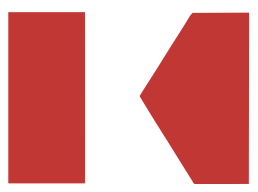
MK: My father, I think, knew that, too. His most famous PR stunt was doing a thing with Château Pétrus back in ’89, when they were regarded as the world’s benchmark for Merlot. Somehow he talked the Pétrus people into coming over here and doing a series of wine tastings — one in New York, one in Los Angeles, and one here at the winery — comparing our ’79, ’83, and ’86 vintages against their same vintages. And though I think the New York and LA tastings were trade and press only (writers, sommeliers, and other people who worked in restaurants and retail shops), there was quite a number of people who came to this, understandably, since offering the chance to taste Pétrus would get anybody’s attention. Essentially, the result of the three tastings was a draw. And that, of course, for us was a huge victory: we’d shown that not only were we in the same ballpark but in many ways the equivalent of Château Pétrus — though, at a much lower price point, as Frank Prowell dryly noted at the end of his article in the New York Times. It was a huge score for us and put us on the map.
So, the net result is that a lot of people who have known us for a long time think of us as a Merlot producer first. And that’s great; I think it’s a wonderful varietal and I think that Spring Mountain will be recognized in the near term as the Number One Merlot appellation in California, if not the Western Hemisphere. It’s got everything that Merlot loves: the right amount of stress on the vines, plus the right combination of clay in the soil combined with tons of rock that give great drainage — and that’s hard to get because usually you have only one or the other. Also, it’s a little bit cooler up here because of the elevation, which Merlot also loves and which gives it a little more acidity and structure. On top of all that, we’ve got the right terroir to really pull out the flavors. So I think the Merlots we’re making here are absolutely world class!
Establishing Identity While Honoring Locality
NM: What was the vision that your father, Robert Keenan, had for the winery when he first established it? And did his vision include wanting specifically to produce a world-class Merlot or did that develop gradually as he went through the process making wines from Spring Mountain?
MK: His original vision was to make world-class Cabernet Sauvignon; that was his real focus. He wanted to compete with the Left Bank First Growths, which, as you probably know, are all Cabernet-based wines. That’s what he’d fallen in love with, that’s what he felt was the benchmark for Cabernet in the wine world, and being a very competitive man, he wanted to compete with the best! After he passed away in November of 2006, I went through all of his papers and found his handwritten notes from the time when he was looking for property in 1974. He had no training in enology or viticulture, but he had a natural green thumb and his real genius was real estate — in fact, his main company was a real estate company — and he knew that the wine business, in the end, was really a real estate business. And that’s because you’ve got to have the terroir, it’s the number one ingredient. Obviously, the human interaction can’t be understated; it’s absolutely essential for humans to make it all happen. But it really starts with terroir — terroir dictates what you’re going to make and how you’re going to make it, and if you’re going to interpret that terroir to its fullest extent.
MK: So, in wanting to compete with the Left Bank First Growth Cabernets, he felt he needed to be up in the mountains. In his notes, he wrote that he only looked at two sites, Spring Mountain and Howell Mountain, without even bothering with the valley. And after looking at both sites, the tie-breaking data for him that made him choose Spring Mountain were two things: first, the primarily eastern exposure that he felt was superior to Howell Mountain’s primarily western exposure; and second, the fact that there’s more water up here — Spring Mountain is called that for a reason: it has a lot of springs! Plus, we get more rainfall than on the opposite side of the valley; this is probably one of the most rainy spots in the whole of Napa Valley, averaging just under 50 inches per year. And almost all of that rain comes between November 1st and April 1st, which is great because it makes for a growing season that’s bone-dry.

MK: As for the Merlot and Cabernet Franc, he had originally planted them assuming they would be secondary grapes used for blending. But he discovered quickly that the Merlot was doing great here, and then a little while later we learned that the Cabernet Franc was great up here too. Since then, I’ve actually converted more acreage over to Cabernet Franc. In fact, looking back at the last couple of years, our most sought-after wine is probably our single-vineyard Cabernet Franc.
NM: Wow, Cabernet Franc your most sought-after wine! Can you tell me more about that and what went into the choice to plant enough of it to produce a viable amount of the varietal wine?
MK: The original planting was designed to use for blending, so there wasn’t much of it, which is also why it’s been one of our most sought-after wines. In one vintage, I think I had 100 cases. But when it got a 94 point score from [Robert] Parker, all of a sudden people were jumping on it. After the ’03 vintage, which at the time was our biggest Merlot vintage ever, we actually couldn’t pick the very top Merlot block in time; I had to just let it go, abandon it, because things were ripening so quickly. I already knew we had a record harvest, so I decided to forget it and just get the Cabernet right when it was perfect — and we did, we jumped on it — and we let the Merlot go. At the end, I realized we had a record Merlot harvest, and we hadn’t even picked the top block so I decided to convert it over to Cabernet Franc. That conversion we didn’t reap the benefits of until 2005, which is the vintage we just finished selling; it’s the first vintage in which we had 600 cases, so we can now actually get out and show the wine and more people can buy it, which is great.
Evolving Practice, Validating Principle
NM: And from what I understand, Keenan wines have definitely evolved in recent years. What are some of the changes you’ve made in the vineyards that you feel have been directly responsible for their improvement?
MK: Probably the one event that compelled us to change the most was having to replant all of the Cabernet Sauvignon vines because they had died of phylloxera. The vines began dying in ’94 and we finished replanting in ’98. Also, two out of three Merlot vineyards and all the Chardonnay had to be replanted, so it was a big chance to reset the whole scene. The biggest change we made was in the big vineyard, the one that you drive around as you come in here — that used to be Cabernet Sauvignon, Cabernet Franc, and Merlot together. On the replant, we decided to do it all with just Cabernet Sauvignon, and chose five new clones that we’d never used before but that were suited for mountainside growing. We also changed the whole way in which we farmed. The old style was terracing, which is what we had, where you essentially re-create the valley by establishing a series of level bands up a hill. On the replant, we got the tractors in there and re-contoured the hill to be smooth, as it had been before we ever started farming it, and planted the Cabernet vines going straight down the hill. Along with that, we’d put in an underground drainage system to catch all the runoff.
And all of this is a relatively new and revolutionary way to plant hillside grapevines. By doing that, we’ve been able to grow cover crops over the last twelve years, basically transforming the vineyard into a giant, living biomass. And it’s so cool to see how it’s all totally changed the dynamic of the vineyard! We had a 9-inch rain event on New Years Eve, I think in ’08, which washed out a big chunk of Spring Mountain Road. Nine inches in one night — that’s a lot of rain! When I came to the vineyard the next morning, I went to look at the collection pond where all the drainage tubes from the vineyard eject into, fully expecting there to be a great deal of runoff to have come off the vineyard. But there actually ended up being very little; the ground had literally sucked up that massive amount of rainwater. Twelve years ago [before we recontoured the hill to allow for cover crops], that would not have happened; it would have all run off.

NM: What this boils down to, then, is that the growth of cover crop between the vines really transformed the composition and behavior of the soil, directly benefitting those vines. Furthermore, you witnessed direct evidence of this, by virtue of the vineyard’s absorbing that large amount of rainwater all at once (and presumably sending it down into the water table) rather than channeling it away.
MK: Yes, and that’s why we describe ourselves as sustainable. My definition of sustainable is that we can continue to do what we’re doing, indefinitely into the future, and continue to improve the environment. That’s the simplest definition of sustainability and one that I think really applies to us.
NM: It also sounds like it improved not only the state of the immediate and wider environment, but also, by extension, the quality of the wines themselves.
MK: Absolutely! There’s no question. Case in point: we just finished blending the ’07 vintage, which every vintner will tell you, from almost every region in California, is the best vintage we’ve ever seen with all varietals; it’s one of those miracle years. At the end of one trial, I turned to Randy and Matt (who have been here for about fifteen years) and said to them, “Ten years ago, did you ever imagine we’d be tasting barrel samples of estate Merlot and Cabernet that had this kind of texture, this voluptuous, pleasure-giving texture, at this age and with tannins that are so well-integrated and so smooth?!” They both said No. So, the results we’ve seen [with the changes we’ve made in the vineyards] are readily observable!
MK: Then I think of 2001, which was our 25th anniversary, as the benchmark vintage where we really began to see these things all come together. That vintage marked the first Reserve Cabernet in our history — the dawning of a new era, it was fantastic — and it came off that [resurfaced hillside] vineyard! And if that weren’t enough, what really surprised me is that the ’03, ’04, and ’05 vintages are all 100% estate Cabernet Sauvignon, with absolutely no Merlot or Cabernet Franc blended into them. Now that is something I never thought I would ever do! Because being raised with Bordeaux wines by my father, we were conditioned to thinking of Left Bank wines as never 100% Cabernet Sauvignon; they’re always blended. I grew up thinking of that as a given truth and one that we certainly practiced here for the first 27 years — until 2003, when we made that first 100% Cabernet. And yet it was never a goal! When we were doing the blending trials, all of a sudden I realized that our Cabernet Sauvignon was complete, lacking no lift in the nose nor lacking any texture. It need nothing more; it was incredibly expressive and complete all on its own. It was amazing!
NM: And, once again, you attribute this to the changes you made in the vineyard’s sustainability.
MK: Yes. And part of the credit has to go to the new clones that we started using that we hadn’t used before — clones that were more appropriate for this mountainside terroir — and also to a more modern rootstock that’s (hopefully) phylloxera-resistant and more adaptable to the mountain terrain. So, it was a lot of things coming together.

Refusing Compromise, Building Reputation
NM: Clearly, then, changes in vineyard management have helped to further your wines’ quality. What are perhaps some other choices you make that directly impact the character of Keenan wines — ones on which you refuse to compromise and that you feel are really salient in achieving the quality that you demand for them?
MK: I think there’s certainly an idea that I’m never going to compromise on what it takes to make the best wine we can make. If that means dropping crop to improve quality, then we’ll do that. If it means not making a bottling in a certain year that we’ve made for a number of years in a row, even if we know we have buyers waiting for it but it’s just not good enough, then we won’t do it. As an example, we usually do a wine called Summer Blend — a blend of Chardonnay, Viognier, and Marsanne, all fermented non-malolactically, and very pure, young, and fresh in style — but this year, since the Viognier wasn’t good enough, it just didn’t work. I know we’ve made some of our wine club members unhappy because they look for that wine every year, and they would have bought it sight unseen like they do every year. But we still decided against producing it, because even though we know it would have been successful and sold out, it just wasn’t good enough to meet our standards. We also don’t make a Reserve Merlot every year, for the same reason. We’ve done it every year since ’02, but we didn’t do one in ’01, which was actually considered a great year. And I had made that decision because ultimately we really weren’t able to tell its difference in quality from the Napa bottling, which is a blend of our estate fruit with Carneros fruit and the one we make the most of. There just wasn’t a quantitative leap in quality in the Merlot that year [that would have been high enough to justify making a Reserve Merlot].
So, it’s that kind of decision-making that we’re constantly doing — quality is always the most important thing, what goes into that bottle. Because when those wines go out, I want people to be really impressed and feel like they got a deal with every bottle, regardless of whether it’s $96 for the Reserve Cabernet or $36 for the Napa Merlot. I want to over-deliver. And that’s the philosophy I’ve had from the beginning of my career as a small-businessman: if you over-deliver, you establish a reputation and it’s bullet-proof, people can bank on it. Doing that, you’ll always have a market, regardless of the economic situation (and now is a great example). A lot of guys who are priced higher than I am, which is most of Napa wines, fall into this category — the market is saying No to all those wines, and they’re having to make some tough decisions on how they’re going to sell. We’re seeing some of that, but in the end, it’s not really a problem; our wines are still moving. If you over-deliver consistently, you’ll always get your share of the pie.

Expanding Vision, Confounding Expectation
NM: You’ve mentioned having a great deal of success with varietals other than Merlot. Would you say that you’re still known as a premium Merlot producer, or do you feel, perhaps because of the new plantings with new clones and a better understanding of site specificity, that you’re now known equally, if not even more so, as a premium Cabernet producer?
MK: Some people still think of us as a Merlot producer, which is great. But since ’01 and with the reviews we got from [Robert] Parker, the Cabernet Sauvignon, the Cabernet Franc, and our [proprietary] blend Mernet have soared to the top, outshone the Merlot, and pushed it to a secondary position. So there’s no question that there’s been a bit of a shift. And really, we do have an ongoing dialogue among ourselves here: “What is truly our best varietal? What’s the feedback from the vineyard? Is it Franc? Is it Sauvignon? Is it Merlot?” If you look at France, where they’ve been growing wine for over a thousand years, they really have precise definitions codified into law as to what you can grow and where — you simply cannot grow Pinot Noir in the Loire or in Bordeaux. It’s amazing how far it’s gone! Up here, we’ve gotten very strong results from all three varietals, so the feedback is not quite clear; we’re still in the discovery process, even after 30-some years!
And also, what the market says (as far as feedback) is one thing, and we certainly know what that data is. But that, to me, is not the ultimate barometer of what’s our best because market conditions change and things go in and out of favor. Merlot obviously has not been at its peak in the last few years, since the movie Sideways came out — though I think that’s changing already. Plus, as I’ve said from the beginning when that movie first came out, the net result of that movie will actually be good for Merlot and bad for Pinot Noir. The overall gene pool for Merlot has gotten better because mediocre Merlot has been pulled out of the market, and people have been ripping out Merlot were it perhaps didn’t thrive, planting Pinot Noir instead — where it won’t thrive either. And so the overall quality of Pinot Noir is now going down.
NM: Essentially, then, with Pinot Noir we’re beginning to see a rehash of what occurred in the early ’90s here in the States: the boom in Merlot’s popularity compelled widespread plantings of the varietal in unsuitable sites, which, combined with high yields (to pre-emptively meet the spike in demand), ultimately resulted in vast amounts of insipid Merlot in the marketplace.
MK: Yes! Americans love trends, they love fads. But in the wine business, if you’re driven by that, you can’t have the model that we have here. We’re an estate winery, so we can’t follow trends; we have to interpret what we do best here and stick to it. And I believe that if you do your best and you’re making a great product, then you’ll find your market, regardless of what you’re growing. Trends will perhaps make it a little easier or a bit more difficult. But if you’re really going to follow those trends, you need to be a négociant-style producer who doesn’t own property, who buys bulk juice that becomes available, packages the stuff with clever labels, and so is mainly a marketing entity. Our model is the estate model, which is the First Growth Bordeaux model: you pick a place where you think the terroir is A+, you stick to it, and then you keep reinterpreting it, getting better at it and ultimately establishing a reputation.

NM: In light of all that, what what would you tell someone who has allowed themselves to be influenced by the negativity Merlot has suffered (the more recent upswing notwithstanding), and therefore sees very little point in spending money on wine they ultimately think of as a passé varietal — especially from a region where, many would argue, Cabernet is king?
MK: One of my favorite ways to answer to that sort of question is to tell someone that the wine I drink most at home, by a large margin, is our Merlot. And that’s because I feel it’s the best food wine we make; it pairs with the widest range of food, so it gives me the most pleasure. I can drink whatever want, but I voluntarily drink Merlot more than anything else. So, if I’m considered an expert in the field and that’s my choice, then that’s a good reason for someone to at least try the Merlot! {chuckling} Though I’ve also softened over the years; ten years ago, with that same scenario, I’d be all energized in wanting to tell them about Merlot and try to convince them that they really need to change their mind. But I’ve relaxed in the years since, because I’ve learned that with certain people, it doesn’t matter what you say and it doesn’t even matter what they tast; their mind will override it if they’ve got their mind set on something. On the other hand, if they’re open, the easiest thing to tell people is, “Try it!” Winetasting is generally free — we bend over backwards to get our product into your mouths! {laughter} So there’s no reason why you shouldn’t try it with an open mind.
Nodding to the Past, Looking to the Future
NM: Speaking of open minds, one thing that really struck me was your mentioning that much of the inspiration for Keenan’s own wines came from the those of Bordeaux. I find it somewhat uncommon for people in California’s wine industry, even among your colleagues in Napa, to openly express a sense of reverence or respect for Old World winemaking history. It might be said that some producers even downplay Europe’s historical significance in their understanding and appreciation of wine — all in an effort to assert a pioneering mentality with a purely Californian identity. What’s your take on that?
MK: I’ve got no problem with that. To me, that’s one of the strengths of our culture, and not only in California but America in general; there’s room for everybody. If you want to throw your money in the game and get a stake, you can do it in any way you want! I also think that we’re working within a fundamentally different paradigm than that which has happened historically in Europe, where there was greater stratification in society. Fifty years ago in France, if you were born in a village to parents of modest means, you could never even dream of owning a First Growth Chateau; that’s just wasn’t going to happen. But in this country, if you have success in some business and have money to invest or even if you start from the bottom, then you have the chance to work your way up, end up with a great piece of property, and then make a wine that can get a great score and be among the best. That’s never happened before in the world; it’s a novel concept. So, I’ve got no problem with people having different points of view in California — it’s great; to each his own!

My path has been my path and you can see why I have my views. I mean, I do know that I’m making California wines; there’s no question about that. There’s a sense of history and background that gives me a frame of reference, but I’m fully aware that the wines we’re making are definitely, uniquely Napa. Actually, they’re uniquely Spring Mountain; I like to differentiate the two because it’s all about identifying your terroir, and this terroir here is unique. But, to your question, I understand it and I think that’s fine. I think it’s part of the spirit that’s really made this country what it is — people who say, “Screw the past! I’m going to cut my own path, be a pioneer, and discover something new!” That’s wonderful!
NM: Do you feel that your own nod to the past and to the Old World has been an advantage to Keenan as a brand?
MK: I think a lot of people whom I run into in the wine world, who collect wines, certainly have an appreciation for the First Growth wines, and since they know me and hear me talking about them, it gives them something they can really identify with — and that is an advantage for me. I also think the more you’re educated, the better off you are, and so the more you know about the history of your business and what other regions are doing, the better off you are in that business. It just makes your knowledge base broader and gives you more things to pull from in making decisions. So, to answer your question, I’d have to say Yes!
NM: On the subject of nodding to the past while looking to the future, tell me a bit more about your taking over Keenan Winery from your father. How would you describe the experience of carrying on something of this magnitude in the light of the wine industry’s unique demands, and how have you been able to redefine the business with your own vision while still honoring and staying true to your father’s legacy?
MK: For us, one of our biggest stories is with the progression in generation from my father’s to mine, there was a huge change in the overall philosophy of the business. It was a complete cultural shift. And that was a huge positive, because my father had great ideas and a great vision, but he was not really a great small-businessman. He started off and had great success, critically, right away with the wines that were made; they were really well received. But he honestly thought that after seven or eight years, he would be pretty much done — that the winery would be set, that the course would be set in stone, and that he wouldn’t really have to do the hands-on work that he’d done in the beginning, particularly the talking to journalists, going to wine shows, and hosting distributors. All that kind of stuff he didn’t really like to do. But as most anyone who’s ever run a business knows, especially a restaurant or winery, it has to be run hands-on. On top of that, with his personality, he never got along with any of the winemakers that he hired; he had six winemakers in eight years! He originally came from a culture of paranoia, from World War II, where everybody was out to get you, so trust wasn’t really one of his strong suits. As a result, he never established a successful culture here at the winery of developing relationships with people who worked for him nor of engendering a welcoming mindset.
I came from a totally different culture. I had my own business for twenty years, where I was a general contractor with a partner, and we had a real family-style operation where we really took care of our employees, valued them, and tried to create a holistic environment. It was a wonderful, vibrant community that we were making with our business. So I brought that culture here to the winery, and also became very hands-on and really began to be involved integrally in everything that happened. But I had to re-do everything; the winery hadn’t been doing well at all, it really had suffered. And quality had gone down because of inattention. Matt and Randy were actually getting ready to leave; they were putting out their resumes [out of frustration because] there was no money in the bank to buy anything, it was a terrible situation.

So, I came in to resurrect the winery. And one of the first things I realized was that the personnel seems to be good. Matt and Randy were awesome, and so I started to treat them like I always did with my employees; I would tell them everything that was happening, I would took care of them, and we began to have this wonderful, cooperative relationship. We’ve been together now for eleven years and it’s pretty much a happy family here. And that culture is so important for small businesses — any business, really, but especially for restaurants and wineries, which I think are so similar. In that kind culture of cooperation, there’s a lot of independent work done, people are allowed to do stuff without being micromanaged all the time, there’s trust, and there’s a real team concept. So, while I set the overall tone and direction for what I want, we all really work as a team, together with our consultant, Nils Venge. They all make my job pretty easy because they do such a great job themselves. Overall, we’re very proud of what we’re doing, which is wonderful. And you just can’t put a value on that.
I also think that I’m a pretty creative person. I always have been. When that kind of thinking got brought here, for the first time the winery really had a creative leader with a team concept that has really allowed us to do the best we can with what we’re doing. It’s almost like magic, because every year it keeps getting better! And we get that feedback from the marketplace, from people who have been following the wines. It’s really cool to make people happy with a product [and its turn-around] so quickly.
NM: The winery and the brand, then, have really transformed under your watch! Looking to the future, what do you see for Keenan Winery in the next generation?
MK: Well, I would hope that with each generation, the best thing that you could hope for is a fresh look and the ability to continue learning, to go where we haven’t gone before, to stand on our shoulders (hopefully appreciating what we’ve done) and then perhaps to find new ways to innovate and keep improving. Of course, there are some values that I hope each generation will come to realize are eternal — patience, respect for the past, respect for their elders. But it’s also important to have the freedom to develop their own ideas and to think they could actually make an improvement and bring their creativity to bear in ways only they can, from insights where maybe their generation thinks a little differently. Essentially, take the best of the new but have respect for the old. Which is what I think I’ve tried to do. When I first took over, I was more than willing to assign all the problems of the winery to my the defects of my father’s personality — and there were many! After a number of years when those problems were ironed out and we were marching toward a successful point, my perspective got a little bit richer and deeper, and I began to really appreciate his vision and the strengths of his personality. And that was a good circle for me to go through, to get through the negative and past the point where I had to prove to myself that I was better than he was. Now, I’d be quite happy to be considered an equal and to be developing new insights based on his original visions, which were great, and to build on that and become not a partner in time but a consecutive partner with a sense of connection and value for him. And that’s been a wonderful journey.

Learning Fast While Slowing Down
NM: In this journey you’ve taken, during this whole process of raising vines and making what truly amount to world-class wines that have carved out a niche and claimed a character all their own, what have you learned that you’ve been able to apply to your life in general?
MK: Since early on in the game — and certainly this message has been repeated quite often — for me, the main thing has been patience. Because I came from the general contracting business where patience was not really part of the deal; we had to make things happen every day on a tight time frame. That mindset for me had to really change. I learned that I couldn’t simply make things happen right away in this business; there really is a time factor here that is much-longer term. And it’s wonderful once you get into that rhythm because it really is a natural rhythm — you have the rhythm of each year with the passing of the seasons, the rhythm of the wines aging in the barrels, the rhythm of when they come to market, etc. So you’re always dealing with what I call multiple dimensions of time: we’re obviously living in the present, which is really your sales that are always happening right now; we’re also dealing with the future, which is the vintage coming up after this growing cycle that’s developing in front of our eyes; and finally we’re looking at the past, in terms of seeing how things worked out that we bottled years ago. There’s always this wonderful mixture of time! So, in the end, patience has been the best lesson for me.
Patience, they say, is a virtue. And it’s apparently one that Michael Keenan has learned and embraced in the process of producing wine from the steep hillsides of Napa’s Spring Mountain. Hearing his story was a poignant reminder that by remaining true to the message of the land to which they’ve dedicated themselves to relaying, and staying mindful of its natural ebb and flow, wine producers can’t help but become better human beings. And, in doing so, they inevitably make better wines. To learn more about Keenan’s own portfolio of wines and how to get them, visit Keenan Winery online.
Interview by Nikitas Magel
Photos by Keenan Winery

Comments are closed.

